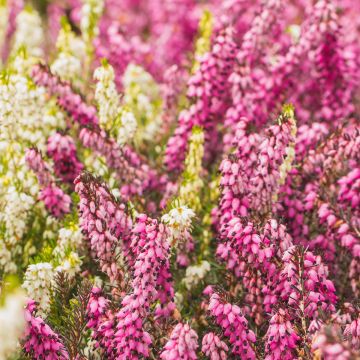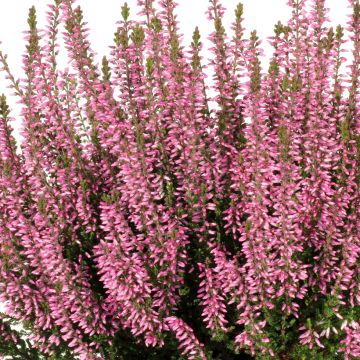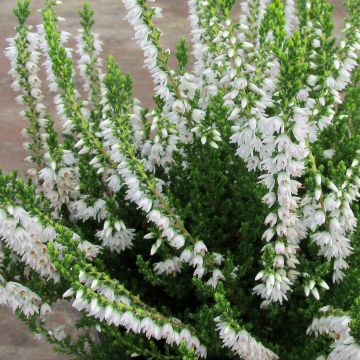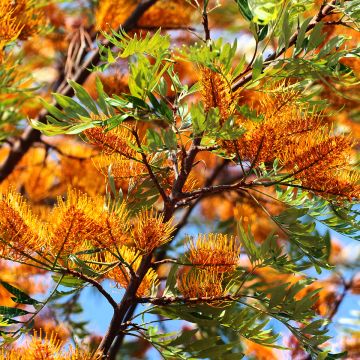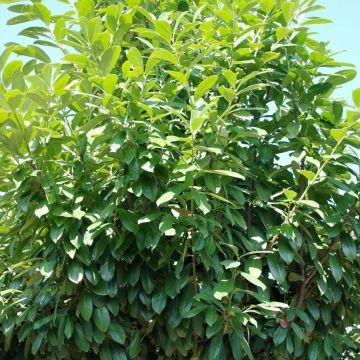

Erica manipuliflora 'Valerie Griffiths'
Erica manipuliflora 'Valerie Griffiths'
Erica x griffithsii 'Valerie Griffiths'
Heather 'Valerie Griffiths'
This item cannot be shipped to the selected country
Delivery charge from €5.90
Delivery charge from €5.90
More information
Schedule delivery date,
and select date in basket
This plant carries a 12 months recovery warranty
More information
We guarantee the quality of our plants for a full growing cycle, and will replace at our expense any plant that fails to recover under normal climatic and planting conditions.
From €5.90 for pickup delivery and €6.90 for home delivery
Express home delivery from €8.90.
From €5.90 for pickup delivery and €6.90 for home delivery
Express home delivery from €8.90.
Does this plant fit my garden?
Set up your Plantfit profile →
Description
Erica manipuliflora 'Valerie Griffiths' is a variety of summer heather distinguished by its yellow summer foliage and its golden yellow tones in winter. Between July and October, its branches are adorned with a multitude of small bell-shaped flowers in pale-pink. Standing about 40cm (16in) tall, it spreads to form a dense cushion with evergreen foliage all year round. Not demanding in terms of soil type and exposure, it requires little maintenance. It is accessible to all gardeners and can easily find its place in any garden.
Erica manipuliflora 'Valerie Griffiths' is a summer heather, selected by Professor John Griffiths, resulting from the deliberate cross-breeding between E. vagans 'Valerie Proudley' with golden foliage and E. manipuliflora 'Aldeburgh' with pink flowers. This cultivar boasts healthy and robust vegetation. It forms a small evergreen bush with a spreading habit, reaching 0.3 to 0.45m (1ft) in height and 0.45m to 0.6m (1 to 2ft) in width at maturity. It grows slowly and its lifespan does not exceed 12 to 15 years. Small needles, 5 to 7mm long, grow on thin and twisted branches, arranged in whorls of 3 or 4, with a tender greenish-yellow colour in spring, turning yellow in summer, and eventually taking on golden yellow hues in winter. It produces small pale-pink bell-shaped flowers from July to October, measuring 4 to 5mm in length, arranged in long spikes measuring 3 to 7cm (1 to 3in), scattered along the branches. The flower consists of a corolla in the shape of an urn or bell with 4 small lobes and 8 free stamens. The protruding purple anthers give the flowers an elegant appearance. They are popular with bees.
Erica manipuliflora 'Valerie Griffiths' has all the qualities one expects from a heather. It boasts a long and remarkable flowering combined with ever-evolving evergreen foliage throughout the seasons. Its low, dense, and compact growth means it can be used in ground cover beds, as border plants in ericaceous beds, on banks and rockeries, to dress the base of trees and large shrubs, and to fill in undergrowth areas. However, avoid excessively hot exposures. It prefers acidic to neutral soil, but it can adapt to slightly alkaline soil. In any case, well-drained soil without stagnant moisture is essential. It does not tolerate long periods of drought well and appreciates moist soil. Mulching will help maintain relative soil moisture.
Almost maintenance-free, 'Valerie Griffiths' only requires light pruning after flowering, in October. It can be planted alongside other heathers whose flowering will take over, while having similar growth and development, such as E. x carnea, E. x darleyensis, or E. vagans. Its long summer flowering brightens up shaded areas with its vibrant colours. It brings whimsy and cheerfulness to low-growing grassy beds such as carex, ophiopogon, molinia, uncinia, hakonechloa, pennisetum, etc. It can also be mixed in a low and shaded bed with andromedas, bearberries, pachysandra, or Lithodora fruticosa. In acidic soil, heathers form beautiful carpets at the base of larger shrubs: mountain laurel, rhododendrons, camellias, deciduous azaleas, andromedas, etc. Cultivated in pots or containers, it enriches balconies and patios with its intense flowering.
Report an error about the product description
Flowering
Foliage
Plant habit
Botanical data
Erica
x griffithsii
'Valerie Griffiths'
Ericaceae
Heather 'Valerie Griffiths'
Erica manipuliflora 'Valérie Griffiths'
Cultivar or hybrid
Other Calluna - Common Heather
Planting and care
It prefers fairly fertile soil, although it can tolerate poor terrain. However, it should be peaty, light, sandy, acidic to neutral (pH between 5 and 7), moist and well-drained to dry. A mixture of 1/3 ericaceous soil, 1/3 non-calcareous organic soil, and 1/3 sand is ideal for pot and garden planting. Ideally, plant in autumn to benefit from winter rooting or in spring. Avoid burying the collar too much. This plant appreciates non-scorching full sun or partial shade. In cooler regions, it is possible to plant them in full sun. In hot climates, a partially shaded exposure is preferable. A well-established plant can tolerate some drought for a short period. It is sensitive to root rot and will die in heavy and poorly drained soil.
In the first two years, carefully weed around the base. Adapted to dry environments, the roots of summer heathers are highly branched in the soil and prevent the establishment of other species nearby once they are well-established. In case of prolonged drought, mulch the base to maintain some moisture.
Prune the clumps to half height, just after flowering, from a young age. This will help the clumps to remain dense while producing fresh foliage. A covering of shredded bark or peat is beneficial in the coldest regions.
Planting period
Intended location
Care
This item has not been reviewed yet - be the first to leave a review about it.
Evergreen shrubs
Haven't found what you were looking for?
Hardiness is the lowest winter temperature a plant can endure without suffering serious damage or even dying. However, hardiness is affected by location (a sheltered area, such as a patio), protection (winter cover) and soil type (hardiness is improved by well-drained soil).

Photo Sharing Terms & Conditions
In order to encourage gardeners to interact and share their experiences, Promesse de fleurs offers various media enabling content to be uploaded onto its Site - in particular via the ‘Photo sharing’ module.
The User agrees to refrain from:
- Posting any content that is illegal, prejudicial, insulting, racist, inciteful to hatred, revisionist, contrary to public decency, that infringes on privacy or on the privacy rights of third parties, in particular the publicity rights of persons and goods, intellectual property rights, or the right to privacy.
- Submitting content on behalf of a third party;
- Impersonate the identity of a third party and/or publish any personal information about a third party;
In general, the User undertakes to refrain from any unethical behaviour.
All Content (in particular text, comments, files, images, photos, videos, creative works, etc.), which may be subject to property or intellectual property rights, image or other private rights, shall remain the property of the User, subject to the limited rights granted by the terms of the licence granted by Promesse de fleurs as stated below. Users are at liberty to publish or not to publish such Content on the Site, notably via the ‘Photo Sharing’ facility, and accept that this Content shall be made public and freely accessible, notably on the Internet.
Users further acknowledge, undertake to have ,and guarantee that they hold all necessary rights and permissions to publish such material on the Site, in particular with regard to the legislation in force pertaining to any privacy, property, intellectual property, image, or contractual rights, or rights of any other nature. By publishing such Content on the Site, Users acknowledge accepting full liability as publishers of the Content within the meaning of the law, and grant Promesse de fleurs, free of charge, an inclusive, worldwide licence for the said Content for the entire duration of its publication, including all reproduction, representation, up/downloading, displaying, performing, transmission, and storage rights.
Users also grant permission for their name to be linked to the Content and accept that this link may not always be made available.
By engaging in posting material, Users consent to their Content becoming automatically accessible on the Internet, in particular on other sites and/or blogs and/or web pages of the Promesse de fleurs site, including in particular social pages and the Promesse de fleurs catalogue.
Users may secure the removal of entrusted content free of charge by issuing a simple request via our contact form.
The flowering period indicated on our website applies to countries and regions located in USDA zone 8 (France, the United Kingdom, Ireland, the Netherlands, etc.)
It will vary according to where you live:
- In zones 9 to 10 (Italy, Spain, Greece, etc.), flowering will occur about 2 to 4 weeks earlier.
- In zones 6 to 7 (Germany, Poland, Slovenia, and lower mountainous regions), flowering will be delayed by 2 to 3 weeks.
- In zone 5 (Central Europe, Scandinavia), blooming will be delayed by 3 to 5 weeks.
In temperate climates, pruning of spring-flowering shrubs (forsythia, spireas, etc.) should be done just after flowering.
Pruning of summer-flowering shrubs (Indian Lilac, Perovskia, etc.) can be done in winter or spring.
In cold regions as well as with frost-sensitive plants, avoid pruning too early when severe frosts may still occur.
The planting period indicated on our website applies to countries and regions located in USDA zone 8 (France, United Kingdom, Ireland, Netherlands).
It will vary according to where you live:
- In Mediterranean zones (Marseille, Madrid, Milan, etc.), autumn and winter are the best planting periods.
- In continental zones (Strasbourg, Munich, Vienna, etc.), delay planting by 2 to 3 weeks in spring and bring it forward by 2 to 4 weeks in autumn.
- In mountainous regions (the Alps, Pyrenees, Carpathians, etc.), it is best to plant in late spring (May-June) or late summer (August-September).
The harvesting period indicated on our website applies to countries and regions in USDA zone 8 (France, England, Ireland, the Netherlands).
In colder areas (Scandinavia, Poland, Austria...) fruit and vegetable harvests are likely to be delayed by 3-4 weeks.
In warmer areas (Italy, Spain, Greece, etc.), harvesting will probably take place earlier, depending on weather conditions.
The sowing periods indicated on our website apply to countries and regions within USDA Zone 8 (France, UK, Ireland, Netherlands).
In colder areas (Scandinavia, Poland, Austria...), delay any outdoor sowing by 3-4 weeks, or sow under glass.
In warmer climes (Italy, Spain, Greece, etc.), bring outdoor sowing forward by a few weeks.





































